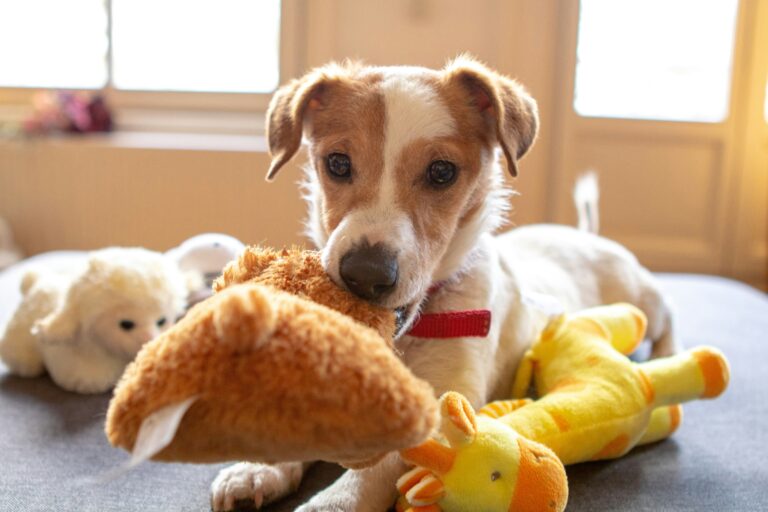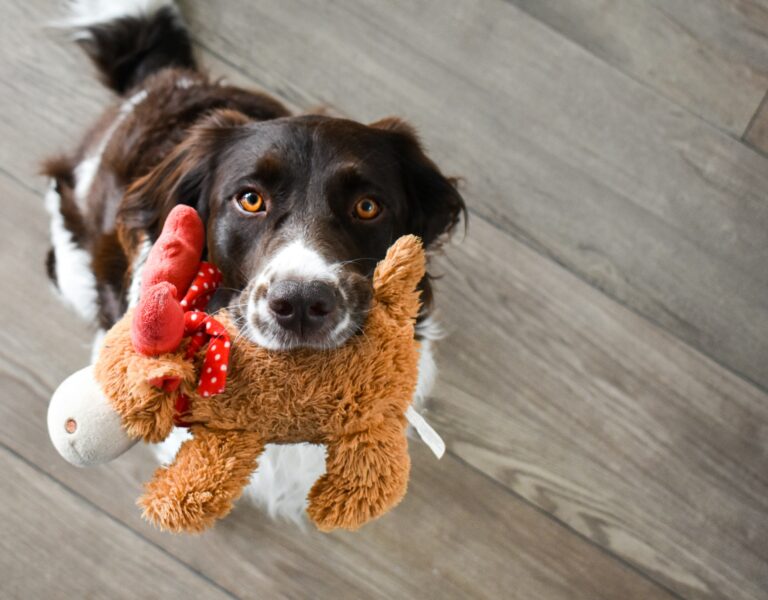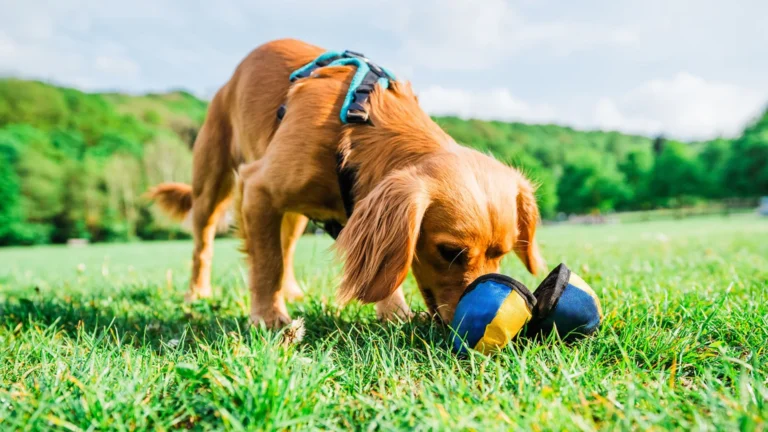Keeping a small dog entertained indoors can sometimes be a challenging task. As an owner of these lovable small breed dogs, you may often find yourself puzzled over how to keep your furry friend amused when outdoor play isn’t an option. From the comfort of your home, this comprehensive guide titled “Fun and Games: Keeping Your Small Dog Entertained Indoors with These Creative Tips!” will surely provide a wealth of creative ideas that guarantee hours of fun for your pint-sized pet.

The detailed tips shared in this guide will help enhance the bond between you and your pet, while also ensuring they stay mentally stimulated and physically active. It will delve into an array of indoor games and activities designed specifically for small dogs, from hide and seek to interactive toys, ensuring your pet’s indoor environment is just as exciting as the outdoors.
With an emphasis on practicality, this guide promises tips that are not just fun but also easy to implement. It will also touch upon the importance of regular playtime for your small dog’s physical health and emotional well-being. Understanding how these activities contribute to their development and happiness will help you better cater to your pet’s needs.
So, if you’re seeking inventive ways to keep your small dog entertained indoors, this guide is a must-read! Gear up to transform your indoor space into a fun-filled playground for your small canine companion. Remember, a busy dog is a happy dog. Let the fun begin! 🐾🏠🐕🦺
Sensory Enrichment Activities for Indoors
Sensory stimulation is just as important for dogs as physical exercise. Dogs explore the world primarily through their senses, particularly smell. When confined indoors, it’s vital to offer sensory-rich experiences that keep their minds and bodies engaged. Scent-based games like “find the treat” are a great way to encourage use of their nose. You can hide a few smelly treats in different corners of a room, under cushions, inside open boxes, or within folded towels, and let your dog hunt them down.

Another form of sensory enrichment is sound. Toys that produce different kinds of squeaks, crinkles, or even musical sounds can captivate your dog’s attention and introduce variety into playtime. Rotating toys every few days also adds novelty, which stimulates curiosity and prevents boredom.
The Role of Routine and Structure
While spontaneous play is beneficial, having a predictable routine that includes designated play periods can make a big difference for small dogs. Dogs thrive on routine and structure. By creating consistent times for indoor play and activities, you provide your dog with a sense of security and expectation.
Morning playtime can help them release pent-up energy, while evening sessions can be more calming, involving cuddly toys or soft interaction. Sticking to a schedule also ensures that they are mentally and physically exercised even on days when outdoor activity isn’t possible.
DIY Toy Ideas for Indoor Fun
Not all toys need to be store-bought. There are plenty of fun, affordable DIY options that can keep your small dog entertained. You can create a snuffle mat using strips of fleece tied onto a rubber sink mat. Hide treats within the fabric folds and let your dog forage.
Another easy project is the muffin tin puzzle. Place treats in some of the muffin cups and cover them with tennis balls or crumpled paper. Your dog has to move the obstacles to find the food underneath. These simple, hands-on projects allow you to customize the difficulty based on your dog’s experience and preferences.
Social Play Indoors
Just because your dog is playing indoors doesn’t mean they have to play alone. Social interaction with humans or other dogs (if available) is highly enriching. Games like gentle tug-of-war using a soft rope toy can provide physical exercise and reinforce your bond with your dog. Be sure to keep it light and controlled, especially for smaller breeds, to avoid strain or overexcitement.
If you have more than one dog, supervised play between them can be highly beneficial. Make sure the games are safe, that each dog is comfortable, and that toys don’t cause possessiveness or aggression. Even short periods of interactive play can fulfill social needs and increase overall well-being.
Environmental Enrichment
Modifying your dog’s indoor environment can encourage exploration and engagement. Consider creating different “stations” within your home. A puzzle station with treat-dispensing toys, a comfort zone with plush beds and cuddle toys, and a play corner with balls or squeaky toys can each serve a different purpose.
Rotate items in these stations regularly to maintain interest. Introduce new textures like fleece blankets, shaggy rugs, or even a pile of towels to burrow in. You can also use different scents to mark zones—lavender for calming areas, and meaty or cheesy smells for active play zones.
Incorporating Technology Into Play
Modern technology can enhance your dog’s indoor play experience. Automatic treat-dispensing devices or motion-activated toys can keep your dog occupied while you’re busy or away. There are even dog-friendly apps and games for tablets that respond to nose or paw touches.
Pet cameras with treat dispensers allow you to interact with your dog remotely, providing encouragement, rewards, and real-time play from afar. These tools not only keep your dog engaged, but also give you peace of mind when you’re not home.
Encouraging Exploration in Limited Space
Even in small apartments or houses, you can encourage exploration. Use furniture to create “mazes” or pathways. Let your dog explore under tables, through blanket tunnels, or over soft pillows. Rearranging familiar objects from time to time changes the environment subtly, keeping it fresh and stimulating.
Always ensure that the space is safe and that your dog can navigate it easily. Avoid placing obstacles near sharp corners or unstable items. If needed, use pet gates to limit access to certain areas while giving your dog a clear and engaging environment to explore.
Calming Activities for Wind-Down Time
After a day of stimulating games and activity, your dog also needs time to relax. Calming activities can help ease the transition from play to rest, especially before bedtime. Licking mats filled with peanut butter or yogurt can be soothing, and slow your dog’s pace both mentally and physically.
Gentle grooming sessions, soft music, and low-light environments can all signal that it’s time to rest. Providing a quiet space with a favorite toy or blanket can help them unwind and settle in for the night.
Utilizing Food-Based Activities
Food can be a powerful motivator and enrichment tool. Using food-based toys such as wobblers, slow-feeders, or treat balls allows your dog to work for their meals rather than eating passively from a bowl. This adds excitement and challenge to their day.
Freezing kibble or wet food inside a Kong toy can extend playtime and keep your small dog engaged. You can also try “meal puzzles,” where different portions of a meal are hidden around the house, combining physical activity with scent work and reward.
Customizing Play Based on Breed Tendencies
Different breeds often have specific instincts and tendencies. For example, a Yorkshire Terrier may love toys that satisfy a prey drive, like those that squeak or wiggle, while a Shih Tzu might prefer comfort and cuddly toys. Understanding your dog’s breed behavior can help you select activities that are more satisfying for them.
For terriers or working breeds, tasks that require solving or digging simulate their natural instincts. For companion breeds, toys that encourage interaction with you or provide soft textures may be more effective.
Addressing Behavioral Challenges Through Play
Some undesirable behaviors in small dogs, such as excessive barking, chewing, or anxiety, can often be alleviated through proper indoor activity. Boredom and lack of stimulation are major contributors to behavior problems. By offering regular and appropriate play, you reduce the likelihood of destructive tendencies.
Use indoor games to reinforce good behavior. For instance, reward your dog with a game of tug after they sit quietly, or use puzzle toys to distract from anxiety during storms or loud noises. Engaging your dog’s brain helps reduce stress and encourages positive habits.
Adapting Activities for Older or Less Mobile Small Dogs
If your small dog is aging or has mobility issues, many of these activities can still be adapted to meet their needs. Soft toys, gentle games like “find the treat” on a mat, and low-impact puzzles are perfect for senior dogs. You can place toys on elevated surfaces if bending is difficult or use slow feeders that don’t require a lot of movement.
Allow your older dog to set the pace. Even brief periods of gentle play can have health benefits. Monitor their energy levels and adjust playtime accordingly to ensure they remain comfortable and safe while staying mentally stimulated.
Making Indoor Playtime a Family Affair
Involving family members in your dog’s playtime can create stronger bonds and help everyone share in the responsibility of your dog’s well-being. Children, under supervision, can participate in games like hide-and-seek or treat puzzles, while adults might enjoy trick training or teaching new behaviors.
Playing together reinforces trust and communication between your dog and each person in the household. Rotate roles so your dog doesn’t rely on just one person for all interactions. This variety also enriches their social experience and helps prevent separation anxiety.
Evaluating Your Dog’s Preferences and Progress
Each dog is unique, and what entertains one may not work for another. Pay attention to your dog’s body language and energy levels to determine which activities they enjoy most. Some dogs may prefer active play several times a day, while others enjoy extended periods of gentle exploration.
Keep track of which toys or games hold their interest, and which ones fade quickly. This can help you make better choices when investing in future toys or planning activities. Adjust difficulty levels and rotate games to maintain long-term interest and challenge.r small dog well-rounded and satisfied.
Conclusion
One effective way to maintain your small dog’s interest is through toy and activity rotation. Just like people, dogs can become bored with the same routine. Rotating toys weekly or changing the type of games you play keeps the experience fresh and exciting. This approach doesn’t require a large inventory of toys—simply cycling through a few can make each reintroduction feel like a new experience.
Similarly, adjusting how you present the activities can reignite your dog’s enthusiasm. For example, changing the layout of a treasure hunt, modifying the rules of a familiar game, or introducing a toy in a different room can spark new curiosity. This variation supports your dog’s cognitive development and problem-solving skills.
Integrating Play Into Daily Chores
Indoor entertainment for your dog doesn’t always need to be a separate event. You can weave small, interactive moments into your daily household routine. Have your dog follow you around the house and reward them for staying close. Ask for a “sit” or “stay” while you cook or fold laundry, or scatter kibble in a different room to turn mealtime into a game.
Dogs enjoy being part of the action. Allowing them to engage in small ways throughout the day gives them a sense of purpose and belonging. These micro-interactions help reduce anxiety and boredom, especially when full attention playtime isn’t possible.
Creating a Safe and Enriching Indoor Environment
The environment itself plays a significant role in your dog’s daily experience. Creating an indoor space that encourages curiosity and comfort can be just as impactful as structured activities. Consider adding a cozy window seat where your dog can observe outdoor activity or placing soft rugs and mats in play areas for traction and safety.
Keep your dog’s play zones free of clutter and potential hazards. Make sure toys are size-appropriate, non-toxic, and inspected regularly for damage. Safety and accessibility are crucial, particularly for smaller breeds who can easily injure themselves on slippery floors or unstable furniture.
Mental Health Benefits of Indoor Play
Beyond the physical benefits, indoor entertainment greatly contributes to your dog’s emotional well-being. Dogs are sensitive creatures that can experience stress, boredom, and even depression if left under-stimulated for long periods. Regular play and interaction help alleviate these feelings by offering an outlet for energy and emotional expression.
Engaging games and positive reinforcement also build confidence, especially in more timid dogs. By mastering puzzles or learning new tricks, your dog gains a sense of accomplishment and pride. This boost in confidence can translate to more balanced behavior in other aspects of life, such as socialization or adapting to new environments.
Long-Term Impact of Daily Enrichment
Daily enrichment sets the foundation for a long, healthy life. Mental and physical stimulation supports heart health, joint function, and brain longevity. For small dogs who tend to live longer lives than larger breeds, the long-term benefits of regular indoor play are even more crucial.
Consistent engagement through thoughtful activities can delay signs of cognitive decline and promote sustained mobility. By investing time in these small yet meaningful efforts, you’re directly enhancing your dog’s quality of life in their most formative and final years alike.



